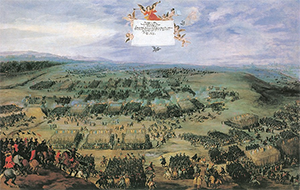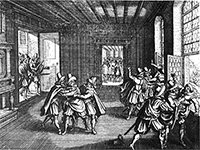Ferdinand II: King of Germany, Holy Roman Emperor
Part 2: A Continent at War Matthias was still emperor when the Thirty Years War began. In 1618, Ferdinand sent a handful of royal representatives to meet with a number of Bohemian nobles at Catholics and Protestants had been trading accusations and blows since the Reformation had begun, in the early 16th Century. When the Thirty Years War began, the two opposing sides were largely congregated based on their religious preference. To the aid of the Bohemian rebels came more Protestants, from the Union states in what is now Germany. To the aid of Archduke Ferdinand II came his nephew, the powerful King Phillip IV of Spain. Spain was already involved in a war in northern Europe. Parts of the Spanish Netherlands had revolted in 1568. The northern provinces formed the Dutch Republic, which took a leading role in opposing Spain and, in effect, Catholic forces during the Thirty Years War. Matthias died on March 20, 1619, in Vienna. Ferdinand was the assumed successor. In the summer of 1619, Bohemian rebels deposed Ferdinand as their leader and handed the crown of their kingdom to Frederick V of the Palatinate (son of the late Frederick IV). Ferdinand might have been indifferent to this fact because he had been, on August 28, elected Holy Roman Emperor. Ferdinand's wife, Maria Anna, had died in 1616. He married again six years later, to Eleonore of Mantua; they had no children together. 
Catholic forces had much early success, and Ferdinand was soon in control of much of northern Europe. One significant victory for the Catholic side was at the Battle of White Mountain, in 1620. Ferdinand II's troops routed Protestant forces under Frederick V and seized control of Bohemia and the Palatinate. The war intensified in the neighboring Spanish Netherlands, and Catholic successes continued. In 1625, Ferdinand won the right of his son Ferdinand to succeed him. In that same year, the emperor employed Albrecht von Wallenstein of Bohemia as a military commander. This turned out to be a success, as Wallenstein was extremely successful, seeing off an influx of Danish troops under King Christian IV and winning a number of battles against Protestant forces. Sweden's King Gustavus Adolphus entered the fray, pushing back imperial forces; and other complaints, Ferdinand sacked Wallenstein and replaced him with Johann Tserclaes, Count of Tilly. That commander died in 1632, Ferdinand recalled Wallenstein, and the imperial successes returned. France stopped sitting on the sidelines and entered the war, adding manpower to large infusions of money that French chief minister Cardinal Richelieu had been granting to the Protestant side. The French entry into the war tipped the balance in favor of the Protestant forces for a time. Swedish forces, augmented by French men and money, continued to win victories. Even Wallenstein turned against Ferdinand, conducting his own negotiations with the enemy, forcing the emperor to dismiss him once and for all. Ferdinand had a modicum of success by negotiating the Peace of Prague, in 1635. The agreement resulted in a general amnesty, which lasted for a time. France declared war on Spain, however, and the resulting conflict again involved German lands. In the midst of the fighting, Ferdinand died, on Feb. 15, 1637. His son, having been elected King of the Romans not long beforehand, succeeded him as Ferdinand III. First page > Empires and Conflicts > Page 1, 2 |
|
Social Studies for Kids
copyright 2002–2025
David White



 Prague Castle. The locals were so offended with Ferdinand's heavy-handed "proposal" that they threw his representatives out a window. Such began the open revolt that unofficially began the Thirty Years War. The actions of those Bohemian nobles came to be called the Defenestration of Prague, fenestration meaning the doors and windows of a building. The four men survived the 70-foot-fall. The symbolic damage, however, was done. (People in Prague had taken such drastic action twice before, in the 15th Century; none of those so defenestrated had survived.)
Prague Castle. The locals were so offended with Ferdinand's heavy-handed "proposal" that they threw his representatives out a window. Such began the open revolt that unofficially began the Thirty Years War. The actions of those Bohemian nobles came to be called the Defenestration of Prague, fenestration meaning the doors and windows of a building. The four men survived the 70-foot-fall. The symbolic damage, however, was done. (People in Prague had taken such drastic action twice before, in the 15th Century; none of those so defenestrated had survived.)
